Kai Yan
School of Land Science and Techniques, China University of Geosciences
Recitation over Reasoning: How Cutting-Edge Language Models Can Fail on Elementary School-Level Reasoning Problems?
Apr 01, 2025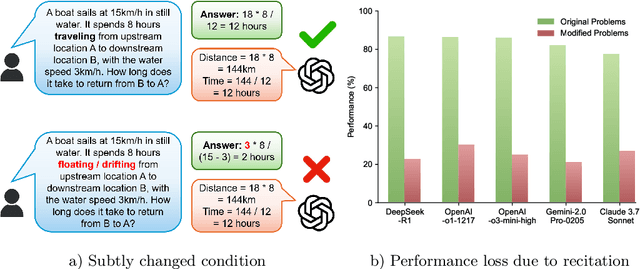
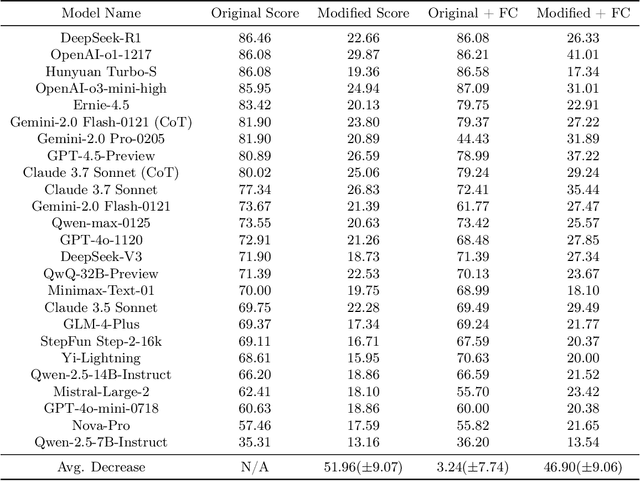
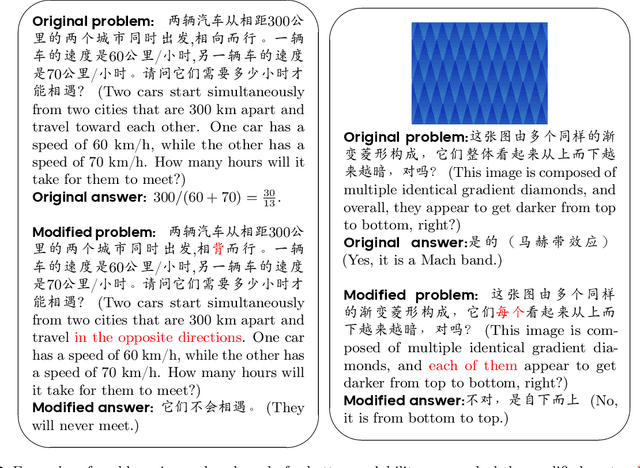
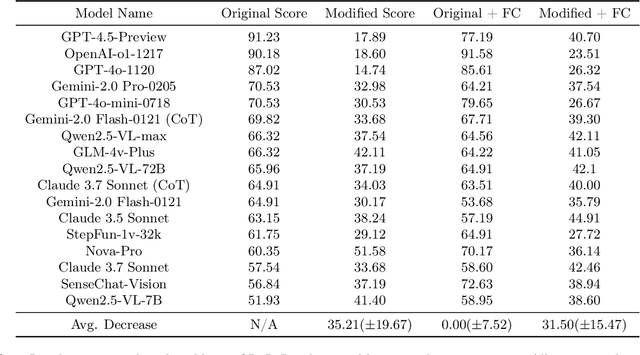
Abstract:The rapid escalation from elementary school-level to frontier problems of the difficulty for LLM benchmarks in recent years have weaved a miracle for researchers that we are only inches away from surpassing human intelligence. However, is the LLMs' remarkable reasoning ability indeed comes from true intelligence by human standards, or are they simply reciting solutions witnessed during training at an Internet level? To study this problem, we propose RoR-Bench, a novel, multi-modal benchmark for detecting LLM's recitation behavior when asked simple reasoning problems but with conditions subtly shifted, and conduct empirical analysis on our benchmark. Surprisingly, we found existing cutting-edge LLMs unanimously exhibits extremely severe recitation behavior; by changing one phrase in the condition, top models such as OpenAI-o1 and DeepSeek-R1 can suffer $60\%$ performance loss on elementary school-level arithmetic and reasoning problems. Such findings are a wake-up call to the LLM community that compels us to re-evaluate the true intelligence level of cutting-edge LLMs.
CodeARC: Benchmarking Reasoning Capabilities of LLM Agents for Inductive Program Synthesis
Mar 29, 2025Abstract:Inductive program synthesis, or programming by example, requires synthesizing functions from input-output examples that generalize to unseen inputs. While large language model agents have shown promise in programming tasks guided by natural language, their ability to perform inductive program synthesis is underexplored. Existing evaluation protocols rely on static sets of examples and held-out tests, offering no feedback when synthesized functions are incorrect and failing to reflect real-world scenarios such as reverse engineering. We propose CodeARC, the Code Abstraction and Reasoning Challenge, a new evaluation framework where agents interact with a hidden target function by querying it with new inputs, synthesizing candidate functions, and iteratively refining their solutions using a differential testing oracle. This interactive setting encourages agents to perform function calls and self-correction based on feedback. We construct the first large-scale benchmark for general-purpose inductive program synthesis, featuring 1114 functions. Among 18 models evaluated, o3-mini performs best with a success rate of 52.7%, highlighting the difficulty of this task. Fine-tuning LLaMA-3.1-8B-Instruct on curated synthesis traces yields up to a 31% relative performance gain. CodeARC provides a more realistic and challenging testbed for evaluating LLM-based program synthesis and inductive reasoning.
LongReason: A Synthetic Long-Context Reasoning Benchmark via Context Expansion
Jan 25, 2025



Abstract:Large language models (LLMs) have demonstrated remarkable progress in understanding long-context inputs. However, benchmarks for evaluating the long-context reasoning abilities of LLMs fall behind the pace. Existing benchmarks often focus on a narrow range of tasks or those that do not demand complex reasoning. To address this gap and enable a more comprehensive evaluation of the long-context reasoning capabilities of current LLMs, we propose a new synthetic benchmark, LongReason, which is constructed by synthesizing long-context reasoning questions from a varied set of short-context reasoning questions through context expansion. LongReason consists of 794 multiple-choice reasoning questions with diverse reasoning patterns across three task categories: reading comprehension, logical inference, and mathematical word problems. We evaluate 21 LLMs on LongReason, revealing that most models experience significant performance drops as context length increases. Our further analysis shows that even state-of-the-art LLMs still have significant room for improvement in providing robust reasoning across different tasks. We will open-source LongReason to support the comprehensive evaluation of LLMs' long-context reasoning capabilities.
Reinforcement Learning Gradients as Vitamin for Online Finetuning Decision Transformers
Oct 31, 2024



Abstract:Decision Transformers have recently emerged as a new and compelling paradigm for offline Reinforcement Learning (RL), completing a trajectory in an autoregressive way. While improvements have been made to overcome initial shortcomings, online finetuning of decision transformers has been surprisingly under-explored. The widely adopted state-of-the-art Online Decision Transformer (ODT) still struggles when pretrained with low-reward offline data. In this paper, we theoretically analyze the online-finetuning of the decision transformer, showing that the commonly used Return-To-Go (RTG) that's far from the expected return hampers the online fine-tuning process. This problem, however, is well-addressed by the value function and advantage of standard RL algorithms. As suggested by our analysis, in our experiments, we hence find that simply adding TD3 gradients to the finetuning process of ODT effectively improves the online finetuning performance of ODT, especially if ODT is pretrained with low-reward offline data. These findings provide new directions to further improve decision transformers.
Natural Adversarial Patch Generation Method Based on Latent Diffusion Model
Dec 27, 2023Abstract:Recently, some research show that deep neural networks are vulnerable to the adversarial attacks, the well-trainned samples or patches could be used to trick the neural network detector or human visual perception. However, these adversarial patches, with their conspicuous and unusual patterns, lack camouflage and can easily raise suspicion in the real world. To solve this problem, this paper proposed a novel adversarial patch method called the Latent Diffusion Patch (LDP), in which, a pretrained encoder is first designed to compress the natural images into a feature space with key characteristics. Then trains the diffusion model using the above feature space. Finally, explore the latent space of the pretrained diffusion model using the image denoising technology. It polishes the patches and images through the powerful natural abilities of diffusion models, making them more acceptable to the human visual system. Experimental results, both digital and physical worlds, show that LDPs achieve a visual subjectivity score of 87.3%, while still maintaining effective attack capabilities.
Open-sourced Data Ecosystem in Autonomous Driving: the Present and Future
Dec 06, 2023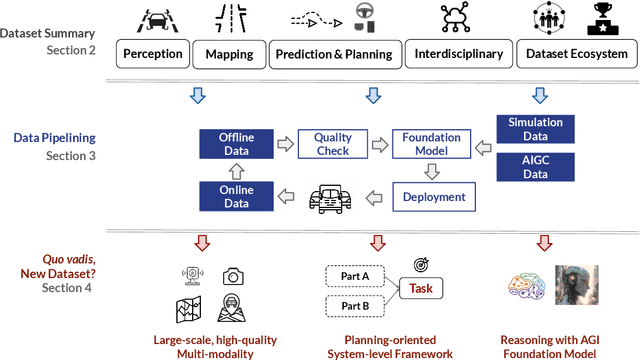
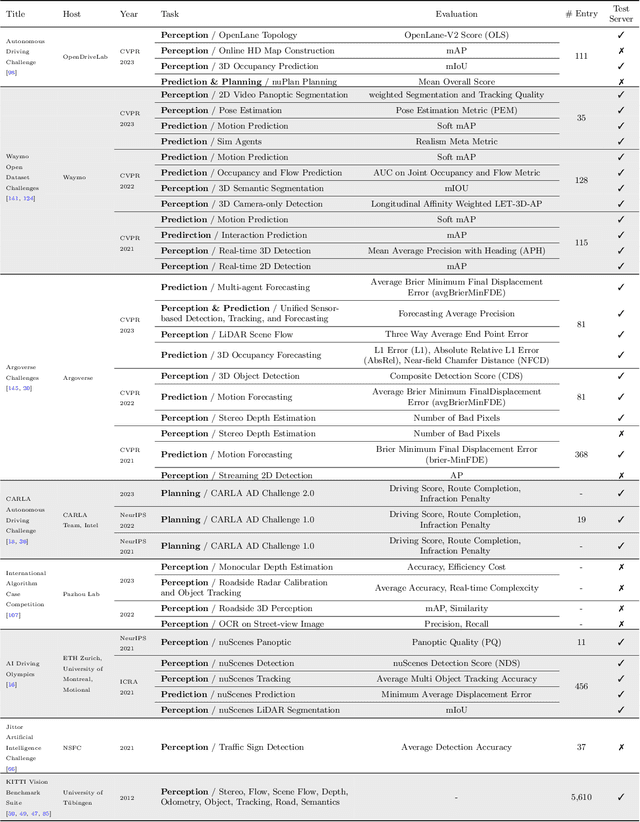
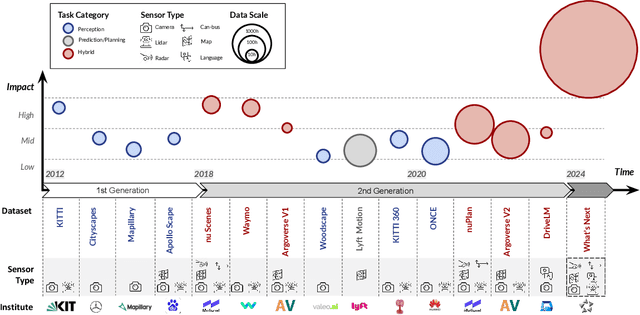
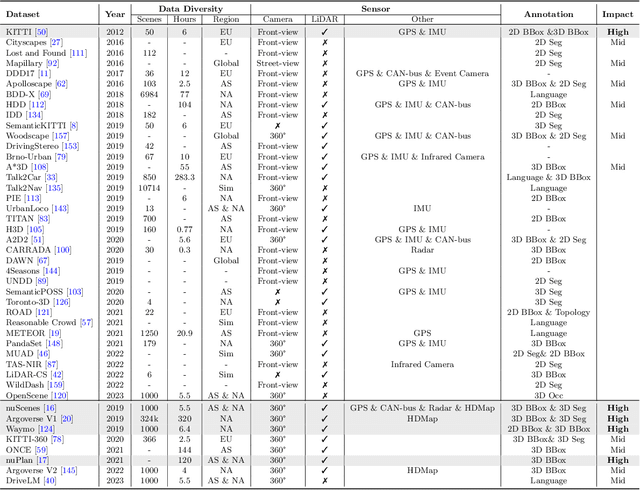
Abstract:With the continuous maturation and application of autonomous driving technology, a systematic examination of open-source autonomous driving datasets becomes instrumental in fostering the robust evolution of the industry ecosystem. Current autonomous driving datasets can broadly be categorized into two generations. The first-generation autonomous driving datasets are characterized by relatively simpler sensor modalities, smaller data scale, and is limited to perception-level tasks. KITTI, introduced in 2012, serves as a prominent representative of this initial wave. In contrast, the second-generation datasets exhibit heightened complexity in sensor modalities, greater data scale and diversity, and an expansion of tasks from perception to encompass prediction and control. Leading examples of the second generation include nuScenes and Waymo, introduced around 2019. This comprehensive review, conducted in collaboration with esteemed colleagues from both academia and industry, systematically assesses over seventy open-source autonomous driving datasets from domestic and international sources. It offers insights into various aspects, such as the principles underlying the creation of high-quality datasets, the pivotal role of data engine systems, and the utilization of generative foundation models to facilitate scalable data generation. Furthermore, this review undertakes an exhaustive analysis and discourse regarding the characteristics and data scales that future third-generation autonomous driving datasets should possess. It also delves into the scientific and technical challenges that warrant resolution. These endeavors are pivotal in advancing autonomous innovation and fostering technological enhancement in critical domains. For further details, please refer to https://github.com/OpenDriveLab/DriveAGI.
Offline Imitation from Observation via Primal Wasserstein State Occupancy Matching
Nov 21, 2023Abstract:In real-world scenarios, arbitrary interactions with the environment can often be costly, and actions of expert demonstrations are not always available. To reduce the need for both, Offline Learning from Observations (LfO) is extensively studied, where the agent learns to solve a task with only expert states and \textit{task-agnostic} non-expert state-action pairs. The state-of-the-art DIstribution Correction Estimation (DICE) methods minimize the state occupancy divergence between the learner and expert policies. However, they are limited to either $f$-divergences (KL and $\chi^2$) or Wasserstein distance with Rubinstein duality, the latter of which constrains the underlying distance metric crucial to the performance of Wasserstein-based solutions. To address this problem, we propose Primal Wasserstein DICE (PW-DICE), which minimizes the primal Wasserstein distance between the expert and learner state occupancies with a pessimistic regularizer and leverages a contrastively learned distance as the underlying metric for the Wasserstein distance. Theoretically, we prove that our framework is a generalization of the state-of-the-art, SMODICE, and unifies $f$-divergence and Wasserstein minimization. Empirically, we find that PW-DICE improves upon several state-of-the-art methods on multiple testbeds.
A Simple Solution for Offline Imitation from Observations and Examples with Possibly Incomplete Trajectories
Nov 02, 2023Abstract:Offline imitation from observations aims to solve MDPs where only task-specific expert states and task-agnostic non-expert state-action pairs are available. Offline imitation is useful in real-world scenarios where arbitrary interactions are costly and expert actions are unavailable. The state-of-the-art "DIstribution Correction Estimation" (DICE) methods minimize divergence of state occupancy between expert and learner policies and retrieve a policy with weighted behavior cloning; however, their results are unstable when learning from incomplete trajectories, due to a non-robust optimization in the dual domain. To address the issue, in this paper, we propose Trajectory-Aware Imitation Learning from Observations (TAILO). TAILO uses a discounted sum along the future trajectory as the weight for weighted behavior cloning. The terms for the sum are scaled by the output of a discriminator, which aims to identify expert states. Despite simplicity, TAILO works well if there exist trajectories or segments of expert behavior in the task-agnostic data, a common assumption in prior work. In experiments across multiple testbeds, we find TAILO to be more robust and effective, particularly with incomplete trajectories.
Language Agent Tree Search Unifies Reasoning Acting and Planning in Language Models
Oct 06, 2023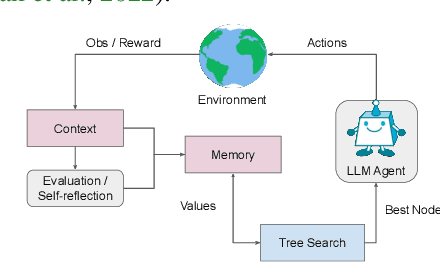

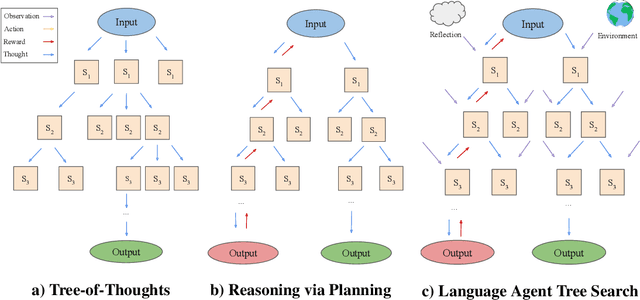

Abstract:While large language models (LLMs) have demonstrated impressive performance on a range of decision-making tasks, they rely on simple acting processes and fall short of broad deployment as autonomous agents. We introduce LATS (Language Agent Tree Search), a general framework that synergizes the capabilities of LLMs in planning, acting, and reasoning. Drawing inspiration from Monte Carlo tree search in model-based reinforcement learning, LATS employs LLMs as agents, value functions, and optimizers, repurposing their latent strengths for enhanced decision-making. What is crucial in this method is the use of an environment for external feedback, which offers a more deliberate and adaptive problem-solving mechanism that moves beyond the limitations of existing techniques. Our experimental evaluation across diverse domains, such as programming, HotPotQA, and WebShop, illustrates the applicability of LATS for both reasoning and acting. In particular, LATS achieves 94.4\% for programming on HumanEval with GPT-4 and an average score of 75.9 for web browsing on WebShop with GPT-3.5, demonstrating the effectiveness and generality of our method.
PSDR-Room: Single Photo to Scene using Differentiable Rendering
Jul 06, 2023



Abstract:A 3D digital scene contains many components: lights, materials and geometries, interacting to reach the desired appearance. Staging such a scene is time-consuming and requires both artistic and technical skills. In this work, we propose PSDR-Room, a system allowing to optimize lighting as well as the pose and materials of individual objects to match a target image of a room scene, with minimal user input. To this end, we leverage a recent path-space differentiable rendering approach that provides unbiased gradients of the rendering with respect to geometry, lighting, and procedural materials, allowing us to optimize all of these components using gradient descent to visually match the input photo appearance. We use recent single-image scene understanding methods to initialize the optimization and search for appropriate 3D models and materials. We evaluate our method on real photographs of indoor scenes and demonstrate the editability of the resulting scene components.
 Add to Chrome
Add to Chrome Add to Firefox
Add to Firefox Add to Edge
Add to Edge